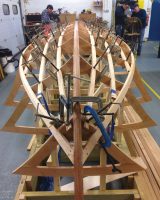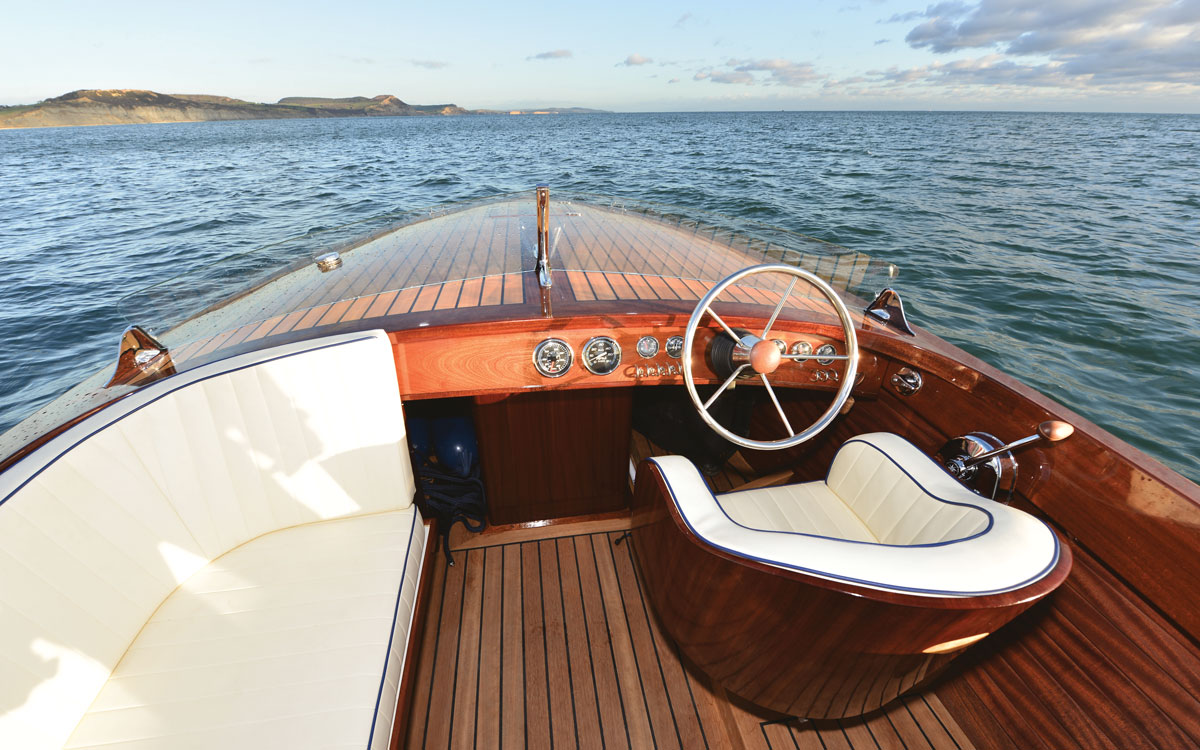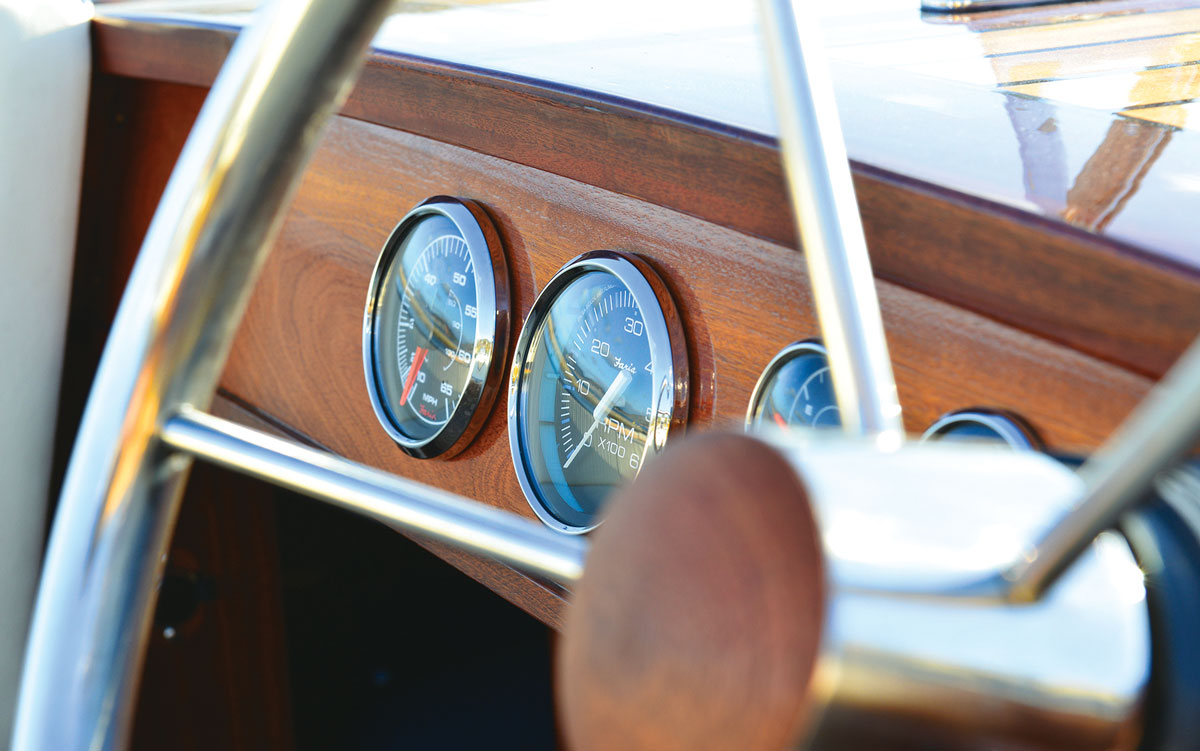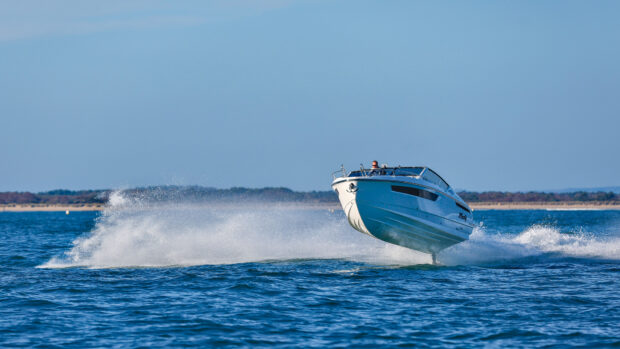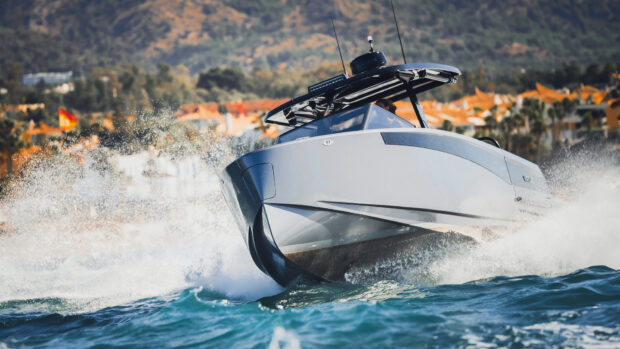After being inspired by a boat magazine article, Simon Hawksley planned and pieced together the vessel of his dreams. Not only the first he'd ever built, but also the first he'd ever owned!
Attempting to log a maximum speed in a small, fast boat always focuses the mind, but today more than ever.
As I line up the varnished bow, grip the stainless-steel rim of the steering wheel and ease the Morse control forward, it occurs to me that the boat I’m about to drive flat out is not only the first boat its creator has ever built, it’s the first he’s ever even owned!
That said, there’s a strong engineering background to Simon Hawksley, the man behind Hawksley Classics and the builder of the boat I’m about to launch at the horizon.
A Masters degree in aerospace engineering was followed by a graduate apprenticeship in a shipyard designing nuclear submarines for four years before he moved to the oil and gas industry. A downturn in the oil industry and the offer of voluntary redundancy created the opportunity to follow his dream, the seed of which was sown several years earlier when he read an article in a boat magazine about the launch day of the Lyme Regis Boat Building Academy.
Simon and his partner Laure moved from Aberdeen to Dorset where Simon enrolled for a course for no other reason than having always wanted to build himself a wooden boat.
A small clinker-built motor cruiser was the original idea, fitted with a single-cylinder diesel engine for slow-speed displacement cruising. But it was whilst researching designs that Simon chanced upon Classic Wooden Boat Plans on the internet, and the drawings for a 16ft speedboat loosely based on an American race boat from the ’60s called Windmill 2 – one of the first sterndrive raceboats.
For Simon, it was love at first sight. Plans were purchased and work at the Academy began. “We stretched the design by 2ft to create more space in the cockpit,” Simon tells me. “Then we drew the plans full sized on huge white hardboard sheets using traditional techniques, clamping batons to the surface to form the lines and create the right curves before then drawing them in pencil.”
It took two and a half weeks to complete, with all three dimensions on the same board and overlapping so that the three different views could reference each other. “It’s a very iterative slow process,” says Simon, “but even having spent ten years in modern CAD engineering, I now don’t see how I could have designed a boat like that on a computer because it would be like looking at the design through a letterbox on a screen.
“Seeing it full size and being able to walk around it, move and change the baton shape until I’m happy with the line and then draw it in is an amazing process.”
The construction is plank on frame, which is similar to traditional cold moulding except that the frames stay in rather than being used as a mould and then removed. The frames are Douglas fir which were initially set up upside down.
Three layers of marine ply were glued together over the frames using thickened epoxy and then two layers of biaxial glass cloth were applied over the top with West Pro-Set epoxy laminating resin, creating additional stiffness and impact protection to the hull. An epoxy filler was then applied over this, then the high-build primer.
“I think we ended up having three rounds of priming and fairing, each with two coats of the high-build primer, so six or seven coats of that in total. Half of it was probably sanded off whilst fairing though – we did a lot of sanding!” says Simon.
The deck is 6mm marine ply covered in 6mm-thick veneers of contrasting Sapele and Spruce. Those wood choices run through the whole boat, the transom for example is Sapele, as is the interior, except the cockpit sole which is iroko. The deep-blue topsides are coated with Jotun Xtreme Gloss, a mix of acrylic and polyurethane two-part spaypaint.
In fact, when the boat was first launched, it was hand-painted in a slightly lighter colour, but when the decision was made that it needed to be darker, a spray finish was used to get a glossier shine, so in total there are five coats of topcoat. Varnish is three coats of polyurethane two pack and four coats of single pack.
Continues below…

Riva 56 Rivale: A veritable floating sculpture full of surprises
With its unique combination of art and design, of engineering and aesthetics, synonymous with the Italian shipyard Riva, the 56

Secondhand buyers guide: Best classic boats
The result is spectacular. An elegant runabout that looks straight out of the ’50s or ’60s, with a reverse tumblehome to the stern quarters almost impossible to mould in GRP. In the cockpit, an L-shaped bench seat runs across the rear and up the port side. Cream marine vinyl on triple layers of reticulated foam features navy fluting.
A single bucket seat for the driver puts them close to the sweep of dashboard, simple stainless bezelled white on black instruments. A little too close, in fact; the pedestal needs moving back a little – it’s on Simon’s to-do list. Small stainless-steel brackets support a frameless venturi screen, which isn’t going to give a great deal of protection on this bitterly cold winter’s day when the MerCruiser 5.7-litre V8 petrol engine beneath the aft deck struts its stuff.
But of more concern is how the hull is going to react. A couple of exploratory runs up to 30 knots give me confidence – it feels benign at these speeds, and responds quickly to both wheel and trim. And when I finally ease the throttle to its end stop, that doesn’t change, the fruits of Simon’s labour ripping across the calm surface until my handheld GPS peaks at 40.8 knots. In truth, I suspect there’s more to come.
The five-bladed High Five propeller is more suited to waterskiing, being tuned for ‘hole shot’ acceleration to snap a skier out of the water rather than outright top end. A conventional three-bladed propeller would likely yield a few more knots. But the overarching feeling is just how well put together the boat feels, with not a creak or a rattle to threaten that feeling of integrity.
It’s an impressive first attempt but it’s not the last. Halfway through the build, Simon and Laure felt there could be a business opportunity in boatbuilding and have created Hawksley Classics, based at a workshop in nearby Bridport. The aim is to build high-quality bespoke craft for clients.
“I’d like the concept to be a little like Eagle E-Type roadsters,” says Simon. “So you get the look and the authenticity of the ’60s original, but it’s underpinned by modern running gear and epoxy construction, and fully sealed wood means that maintenance is kept low, even in regular use”.
Simon’s first boat is being kept as a prototype, with the plan being to build his first production boat using lessons learned. So the rubbing band, for instance, will be D-section stainless steel rather than Sapele wood, there will be more grabhandles, woodwork will be spray-finished and sealed rather than hand-varnished, an electronic throttle/shift control will be smoother than the cable-operated version and of course, that helm seat will be sited further aft.
They’ve even booked space at the exclusive Cannes Boat Show, where they plan to exhibit under their own name for the first time – about as far away from the oil fields of Aberdeen in concept as it is geographically. 
Specification
LOA: 18ft 6in (5.6m)
BEAM: 7ft 3in (2.2m)
DRAUGHT: 2ft 0in (0.6m)
DISPLACEMENT: 1.2 tonnes
TOP SPEED: 40 knots
CRUISING SPEED: 30 knots
HULL CONSTRUCTION: Cold-moulded wood with glass and epoxy layer
For more information contact: www.hawksleyclassics.com






